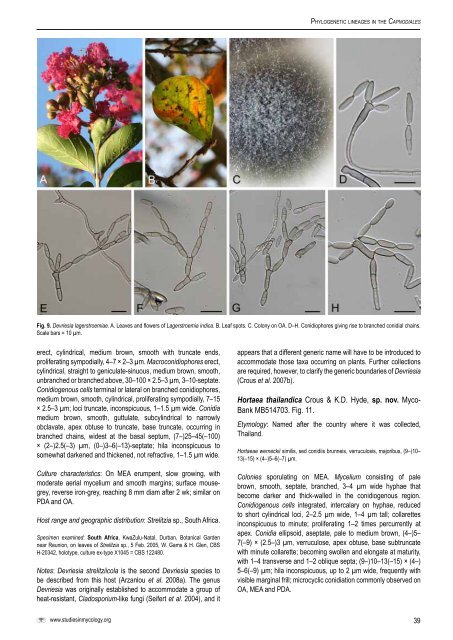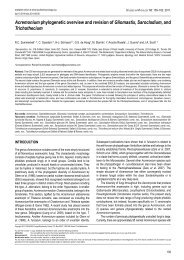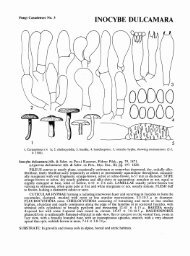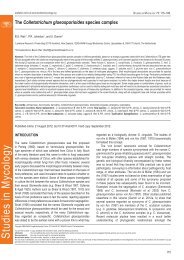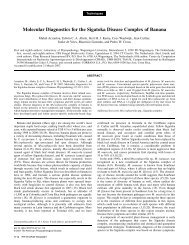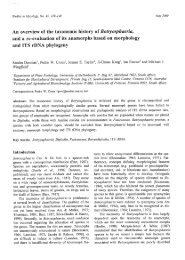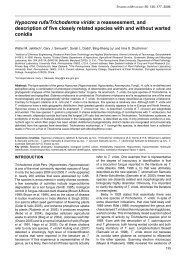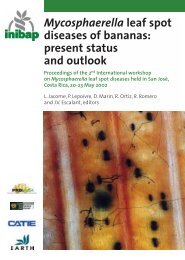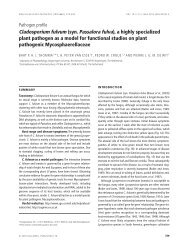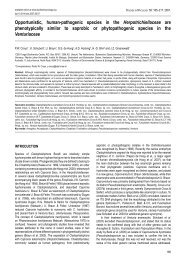Phylogenetic lineages in the Capnodiales - Cbs - KNAW
Phylogenetic lineages in the Capnodiales - Cbs - KNAW
Phylogenetic lineages in the Capnodiales - Cbs - KNAW
Create successful ePaper yourself
Turn your PDF publications into a flip-book with our unique Google optimized e-Paper software.
www.studies<strong>in</strong>mycology.org<br />
<strong>Phylogenetic</strong> l<strong>in</strong>eageS <strong>in</strong> <strong>the</strong> <strong>Capnodiales</strong><br />
Fig. 9. Devriesia lagerstroemiae. A. Leaves and flowers of Lagerstroemia <strong>in</strong>dica. B. Leaf spots. C. Colony on OA. D–H. Conidiophores giv<strong>in</strong>g rise to branched conidial cha<strong>in</strong>s.<br />
Scale bars = 10 µm.<br />
erect, cyl<strong>in</strong>drical, medium brown, smooth with truncate ends,<br />
proliferat<strong>in</strong>g sympodially, 4–7 × 2–3 µm. Macroconidiophores erect,<br />
cyl<strong>in</strong>drical, straight to geniculate-s<strong>in</strong>uous, medium brown, smooth,<br />
unbranched or branched above, 30–100 × 2.5–3 µm, 3–10-septate.<br />
Conidiogenous cells term<strong>in</strong>al or lateral on branched conidiophores,<br />
medium brown, smooth, cyl<strong>in</strong>drical, proliferat<strong>in</strong>g sympodially, 7–15<br />
× 2.5–3 µm; loci truncate, <strong>in</strong>conspicuous, 1–1.5 µm wide. Conidia<br />
medium brown, smooth, guttulate, subcyl<strong>in</strong>drical to narrowly<br />
obclavate, apex obtuse to truncate, base truncate, occurr<strong>in</strong>g <strong>in</strong><br />
branched cha<strong>in</strong>s, widest at <strong>the</strong> basal septum, (7–)25–45(–100)<br />
× (2–)2.5(–3) µm, (0–)3–6(–13)-septate; hila <strong>in</strong>conspicuous to<br />
somewhat darkened and thickened, not refractive, 1–1.5 µm wide.<br />
Culture characteristics: On MEA erumpent, slow grow<strong>in</strong>g, with<br />
moderate aerial mycelium and smooth marg<strong>in</strong>s; surface mousegrey,<br />
reverse iron-grey, reach<strong>in</strong>g 8 mm diam after 2 wk; similar on<br />
PDA and OA.<br />
Host range and geographic distribution: Strelitzia sp., South Africa.<br />
Specimen exam<strong>in</strong>ed: south Africa, KwaZulu-Natal, Durban, Botanical Garden<br />
near Reunion, on leaves of Strelitzia sp., 5 Feb. 2005, W. Gams & H. Glen, CBS<br />
H-20342, holotype, culture ex-type X1045 = CBS 122480.<br />
Notes: Devriesia strelitziicola is <strong>the</strong> second Devriesia species to<br />
be described from this host (Arzanlou et al. 2008a). The genus<br />
Devriesia was orig<strong>in</strong>ally established to accommodate a group of<br />
heat-resistant, Cladosporium-like fungi (Seifert et al. 2004), and it<br />
appears that a different generic name will have to be <strong>in</strong>troduced to<br />
accommodate those taxa occurr<strong>in</strong>g on plants. Fur<strong>the</strong>r collections<br />
are required, however, to clarify <strong>the</strong> generic boundaries of Devriesia<br />
(Crous et al. 2007b).<br />
Hortaea thailandica Crous & K.D. Hyde, sp. nov. Myco-<br />
Bank MB514703. Fig. 11.<br />
Etymology: Named after <strong>the</strong> country where it was collected,<br />
Thailand.<br />
Hortaeae werneckii similis, sed conidiis brunneis, verruculosis, majoribus, (9–)10–<br />
13(–15) × (4–)5–6(–7) µm.<br />
Colonies sporulat<strong>in</strong>g on MEA. Mycelium consist<strong>in</strong>g of pale<br />
brown, smooth, septate, branched, 3–4 µm wide hyphae that<br />
become darker and thick-walled <strong>in</strong> <strong>the</strong> conidiogenous region.<br />
Conidiogenous cells <strong>in</strong>tegrated, <strong>in</strong>tercalary on hyphae, reduced<br />
to short cyl<strong>in</strong>drical loci, 2–2.5 µm wide, 1–4 µm tall; collarettes<br />
<strong>in</strong>conspicuous to m<strong>in</strong>ute; proliferat<strong>in</strong>g 1–2 times percurrently at<br />
apex. Conidia ellipsoid, aseptate, pale to medium brown, (4–)5–<br />
7(–9) × (2.5–)3 µm, verruculose, apex obtuse, base subtruncate<br />
with m<strong>in</strong>ute collarette; becom<strong>in</strong>g swollen and elongate at maturity,<br />
with 1–4 transverse and 1–2 oblique septa; (9–)10–13(–15) × (4–)<br />
5–6(–9) µm; hila <strong>in</strong>conspicuous, up to 2 µm wide, frequently with<br />
visible marg<strong>in</strong>al frill; microcyclic conidiation commonly observed on<br />
OA, MEA and PDA.<br />
39


